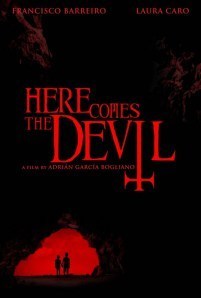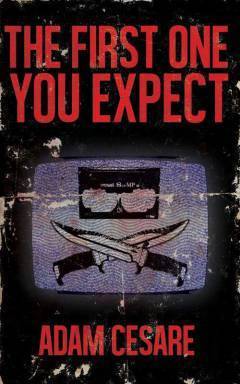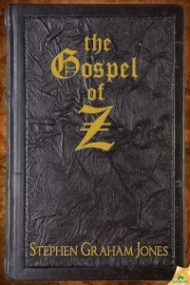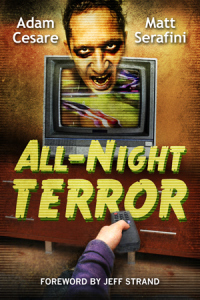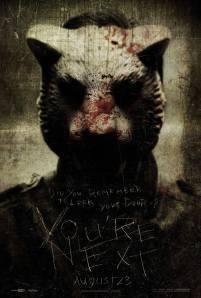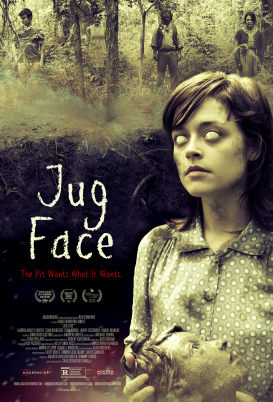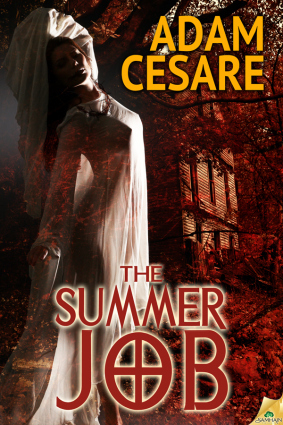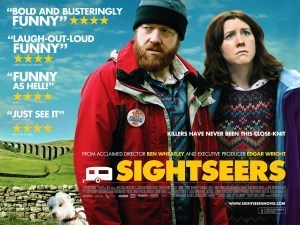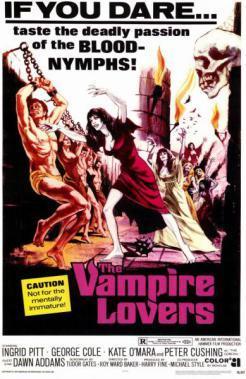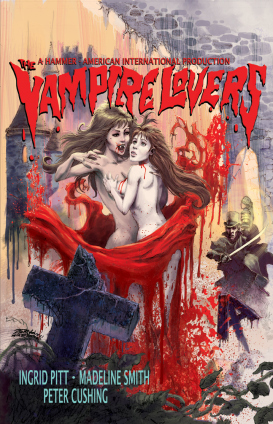Adam Cesare's Blog, page 11
December 14, 2013
The Devil’s Brew: HERE COMES THE DEVIL (2013)
Adrián García Bogliano’s Here Comes the Devil is many things, but at its core it has the bones of a slowburn supernatural thriller.
At its core, being the key words there. That core is caked in inches, maybe even feet, of coagulated blood.
The film begins with soft-focus lesbian gyrations and severed fingers and only ramps up in explicitness from there, so the mix of gratuitous sex and violence combined with the plot’s more metered leanings may not be everyone’s cup of tea.
Not me, though. I love films like this, films that refuse to be boring, that borrow and steal at every turn, but still end up feeling like a cohesive, original work.
And steal Here Comes the Devil does. There’s a Rosemary’s Baby dream sequence, Paranormal Activity shaking house scare tactics, a Park Chan-wook-esque justifiable (?) revenge sequence, a “just one more thing” sequence with a Columbo-ish detective, milky-eyed possession, it even lifts the “ghostly breast manipulation” gag from The Entity. But all of these detours into greatest-hits territory mesh together on Bogliano’s canvas.
In broad strokes, the film is about parents dealing with the return of their two pubescent children (a boy and a girl) after the kids go missing on a cursed hilltop for a day. When summarized like that, the film sounds like something we’ve seen a million times, but Bogliano adds enough detours, complications and reversals to the central mystery that the film goes at least a few places we haven’t seen before, some of them quite disturbing.
We get many traditionally, or at least stereotypically, American story beats transposed to a Mexican setting (Catholicism looming large in the opening sequence, with the mention of a priest, confessional, but its influence becoming less surface-level as the film progresses) by an Argentine writer/director, and the results are uniquely enjoyable. Enjoyable even if it does feel a bit like an exploitation gumbo, especially in the first half, where much of the pastiche is relegated.
Folks expecting their horror films to look a certain way (i.e. MTV slick and cut-laden) might be initially turned off by the film’s aesthetic. There are in-camera zooms, an abundance of split-focus shots and other techniques we’re not used to seeing in our horror flicks (in this decade anyway), but they give the film an almost subliminal throwback feel without the filmmaker having to resort to the hackneyed overlay of artificial weathering.
Stars Laura Caro and Francisco Barreiro do fine work, feeling naturalistic, even when Barreiro’s character has to be purposefully pig-headed (a recurring gag in the film has the couple’s room shaking, the lights flashing, with Felix trying to justify the cause as “people throwing rocks at the house”) and the kids end up sufficiently dead-eyed and creepy.
The film’s available to rent now On-Demand and is doing a limited theatrical run from Magnet Releasing. In what’s beginning to feel like a real dry-spell (at least for the last couple months, where I’ve seen a bunch of films, but didn’t like any of them enough to write them up), you could spend your money on far worse films than Here Comes the Devil.


December 11, 2013
It’s going to be a big month (i.e. a link dump), plus some thoughts about GOSPEL OF Z
So we’re less than a month away from The Summer Job dropping at all fine retailers on January 7th and the reviews have already begun to roll in. I’m proud of all my work but I think this is far-and-away my best book. I guess that’s not really for me to say, though. On with the links!
Big-time, high-profile website Bloody Disgusting and Ryan Daley started things off and I’m heartened, humbled by the four words that end the review: “Cesare’s best novel yet.”
Nick Cato covered it for The Horror Fiction Review (it’s near the bottom of the page). He had some very nice things to say, even though I was initially thrown by the “smell rating” that accompanies the review. Bottom-line: it’s an actual meter of the books aroma, he’s not saying that it “stinks” (har har).
Sean Leonard, writing for Horror News, offers up the most positive, glittering review I’ve ever received. Glad to see that someone enjoyed the Edible Arrangements gift basket that accompanied every review copy.
Blu Gilliand (always a hero for his praise of Tribesmen and putting Video Night on one of his year end “Best of” lists) wrote about the book for FearNet.
Yeah, I haven’t talked about movies on here for a good long time. But I did talk a little bit about movies (among other things) in this interview with Blu for Horror World, so that might be enough until I get back on here, ramble about something.
In the above interview we discuss a crime novella called The First One You Expect so it’s probably best I end this litany of self-promotion with a look at the cover (by the amazing author/artist Matthew Revert). This will be out in February from J. David Osborne’s Broken River Books:
As noted elsewhere by people not half as biased as I, my publisher Samhain has really been on fire lately. And the hits continue next month with the release of The Gospel of Z by Stephen Graham Jones. I’ve been an avowed SGJ fan for a while now, so it’s a real thrill to have a book coming out on the same day, from the same publisher, even if I am going to be trounced by his sales figures.
I’ve gotten a chance to read it early and all I have to say is “Whoa!” Well, that’s not all.
I’ve made this confession before, but I could really care less about zombies. On the big screen we’ve never done better than Romero’s Dawn and we probably never will (because it’s perfect, that’s why). I’ve tried to watch The Walking Dead and couldn’t get into it although I dug the Telltale game (and the comic, once upon a time, even though I’m pretty sure I stopped reading in high school, while all the protagonists still had their limbs, so early, I guess). Whatever marketing synergy/shelf-appeal The Gospel of Z carries has zero effect on me.
Taking place a decade after the bulk of zombie canon, this is not an outbreak story, more of a near-future scenario featuring societal practices that would border on the absurd if they weren’t sold so well. Gospel offers us a world with perilously few people (and very few zombies, while I’m thinking about it), new religions (and cults), a scary-ass “is this kind of society really worth it?” military, suicide missions, flame throwers and exploding goats.
It’s scary, has some really great set-pieces that I could see Hollywood fouling up with CGI, but (like most Jones) never takes one foot out of the realm of “real meal” literature because it’s so well-written (and, in glimpses, very funny). Jones’s books are all very different from each other, it’s kind of his thing (that and they are copious) and this one is no different in the way that it has a very sci-fi feel to it, with its exhaustive invented (or at least specialized) vernacular, peculiar creatures and subcultures. There’s no way to really explain this without over-summarizing, but I think it would be best to say that The Gospel of Z takes a very simple premise (a man who’s got nothing to live for decides to see the girl he’s been living with one last time, even if she’s chosen to go off somewhere that nobody comes back from) and complicates it in the very best of ways.
At one time, apparently, the book was a lot longer than it is now. It’s not something I knew while reading it, but in hindsight it makes sense. Not in a bad way, though, but in a way that this version of Z reads like something that (if it were marketed as sci-fi, targeted to an audience who’s used to marketing shenanigans) would probably have been stretched into a trilogy (or quadrilogy or some other made up word) by a lesser writer. As it is now, it’s DENSE, almost a mythic reduction sauce, all the fluff melted away to make a book that you damn well better not try to read while you’re sleepy, because it’s certainly not going to hold your hand.
I guess that was kind of a non-review. You should buy this book.


October 3, 2013
Enter to win some ALL-NIGHT TERROR [UPDATED with the Winners]
Update:
After spending most of the morning compiling a list of entrants (then counting up their entries and supplying them with a series of numbers) the number generator at random.org has chosen your winners.
First, the two runner ups: Travis Bingaman (who entered through Twitter and I’ll try to get in touch with there) and Stephen Pacino (I think I have your email on your comment) have both won an ebook of their choosing!
The grand prize goes to: Jesse Bollinger! Congrats Jesse! I facebook stalked you after your number came up and I’ve gotta be honest: I’m very happy that you don’t live in a different country, because shipping would have been expensive!
Thank you everyone who played and helped spread the word (especially those who left a review and netted themselves extra entries: Jesse L., Martin R., MichK, and M. Lovato, but didn’t win anything but my undying admiration). I hope to do something like this again soon, although maybe with less bookkeeping needed on my part (the file I’ve been using for this is a list of screennames and numbers, looks like something that gets passed around the NSA).
Hey y’all.
I’m terrible at updating the blog (busy and stuff), but you may have heard that Matt Serafini and I have a new book out.
It’s called All-Night Terror and its a collection of short stories that reads like a classic horror movie marathon, complete with host and wraparound story. I’m really proud of how it turned out, there are three original stories from me and three from Matt (it totals 30,000 words of content and is novella-length, so it should take you about two hours to read).
The cover was created by the wonderful Lynne Hansen and the book comes with a funny-yet-touching forward from Jeff Strand.
Best part is that it’s only three bucks.
The book was released a couple weeks ago, but I’ve been out of town, so let’s call this its official launch and celebrate in style, shall we?
The CONTEST:
This is a no-purchase-needed scenario, but you’ll have a better chance of winning if you drop the three bucks and read the book.
The PRIZES:
The Grand Prize will be a “Night of Terror” furnished by me.
What does that mean? It means I’ll send you two (2) DVDs from my personal collection (if you follow me on twitter or facebook you’ll know I’m into some crazy stuff, so I’m not liable for any heart attacks), one (1) bag of microwave popcorn, and one (1) paperback of your choosing (either Tribesmen, Video Night or, if you don’t mind waiting until January, The Summer Job). I’m just ballparking it, but that’s probably like a $40 value.
Two Second Prize Winners will receive one (1) ebook of their choosing (either Tribesmen, Video Night, Bound By Jade, Bone Meal Broth or All-Night Terror if you didn’t buy it to enter the contest you cheap bastard).
How to Enter:
There are a few ways to enter, some of them worth more entries than others.
The simplest (and cheapest) way to enter is to go on twitter and send out this tweet:
I’m looking to win some ALL-NIGHT TERROR from @Adam_Cesare and @Mattfini: http://bit.ly/18TBnYD
You can tweet that as many times as you want, but it’s still only going to count as one (1) entry. If you don’t have a twitter account you can still share this blog (just tell me where to see the share) to get your free entry.
To get FIVE (5) entries, what you have to do is buy the book and then leave a short, unbiased review on Amazon. Yeah, bad reviews count, but I think you’ll like the book, besides you don’t want me sneezing on your prizes, do you? Amazon flags all “legit” reviews as “Verified” so make sure you actually buy the book before reviewing or it won’t count.
You can grab an additional two (2) entries by copying and pasting your review to Goodreads or your own blog.
Comment on this post with your amazon name or blog so I know that you’ve entered.
I’ll determine the winner using a random number generator on a little before midnight on Halloween (that’s October 31st).
Good Luck!
There should be more prizes!
Okay, well, if All-Night Terror has fifteen (15) reviews on its US Amazon page before the end of the contest, I’ll choose two (2) Grand Prize winners and four (4) Runners Up! What a deal!
The fine print:
Yes, this book is digital exclusive, but before you whine about not having an ereader, remember that Kindle books can be read on any tablet, smartphone, computer or microwave, so nobody’s getting left out.
Yes, I will ship overseas, but just know that I’ll be sending region one DVDs so I hope you have a regionless player.
Yes, you can do everything on the list and wind up with a whopping twelve (12) entries!
Yes, I’ll work with the winner and give them some options regarding DVD prizes. I don’t want to send anyone a disc that they already have. These will be store-bought discs, no cheapo dollar-store stuff or absolute dreck. Okay, maybe some dreck, but it’ll be PREMIUM dreck.


August 8, 2013
Making sure your door is locked two or three times a night with YOU’RE NEXT
Last night I attended a preview screening of Adam Wingard’s You’re Next and before I entered the theater I was talking with a friend who’d just seen the film at this year’s Fantasia Film Festival. I’d heard good things since the film premiered at festivals a few years ago, but I still had to ask him what he thought. His answer was “it’s really fun.” It was not a negative comment, but still something that perplexed me, given the film’s dark-bordering-on-nihilistic advertising.
He was totally right, the movie is fun. It’s also excellent.
Right from the opening sequence the filmmakers suffuse You’re Next in a cloud of black comedy that is completely at odds with the film’s marketing, but so very welcome. Seeing this with a packed Philadelphia audience, I can tell you that this is a movie that plays and plays well.
The story of a large, wealthy family that finds their remote mansion under siege by a pack of crossbow and machete-wielding killers, You’re Next uses its minimal downtime effectively. Before the situation escalates, we get a good sense of the family dynamics and a healthy dose of laughs. Once the killing starts, the tone of course shifts towards the dire, but You’re Next never quite wipes that evil smirk off its face.
You’re Next trades the moral ambiguity of Straw Dogs and the dourness of the more recent The Strangers for crowd-pleasing moments that absolutely kill in a packed theater. This may be the home invasion subgenre at its most accessible, but that is certainly no reason to discredit it. I don’t want to over-emphasize the “fun” of the film, because it still offers scares and gore in spades (with more than one memorable jump scare), but it’s the mixing of tones that makes this film work.
In the most recent issue of Rue Morgue there’s a chart showing how Wingard and company (writer Simon Barrett, Joe Swanberg, etc.) find themselves pulling double and triple duty on each other’s films. I’ve seen most of the films on that chart and while I’ve loved some of them and not others, I have to say that I think You’re Next is the group’s best effort to date. When Larry Fessenden plays one of the first characters we meet and then Ti West pops up ten minutes later, the beginning of the film can start to feel a bit like the It’s a Mad Mad Mad Mad World of horror directors, but the presence of these familiar faces never feels like anything other than “we’re getting our friends together to help with this movie.” Something that is truly admirable, given how great the final product turns out to be.
The cast all performs commendably, even the members not known for their acting, but the real standouts are Shari Vinson and genre superstar Barbara Crampton. Vinson turns in one of the most memorable “final girl” performances in a long while and it’s great to have Crampton back on screen (hers is a performance with depth, a refreshing change of pace from the way that most genre stars are utilized as stunt-casting). These two performers are marvelous and I hope that this film’s wide distribution means that we’ll be seeing more of them soon.
Talking with a group afterward, it seemed that the film’s third act was also its most divisive aspect. I don’t want to spoil anything, but I will say that I think everything about the ending is layered in the film’s first half and cohesive with the thematic content at work (chief among them economic entitlement and quarter-life malaise). Basically, people are always going to find narrative threads to pull at, but that doesn’t mean that a film is any less enjoyable for those that don’t feel the need to compulsively nitpick.
With the discussion of “simple vs. smart” taking place recently in fandom with regards to Pacific Rim, You’re Next is a simple film that approaches its premise in an abundantly smart way.
Highly recommended, also highly recommended that you try to see it with an audience.
Bonus, if you’re into seeing people be put down for their poor grammar, someone started a twitter account that retweeted people using the improper form of you’re when talking about the movie. The account seems to have been suspended, but it was funny while it lasted.


July 11, 2013
JUG FACE and some other odds & ends
Chad Crawford Kinkle’s debut feature Jug Face is not the kind of film we get to see often. That’s a good thing.
Probably best billed as Winter’s Bone meets The Children of the Corn, Jug Face has a bit more going for it than that. Although it is neither, the film locates the sweetspot between charming indie-feature stocked with enjoyable character actors and splatter-filled Southsploitation sicky.
Slick photography and fine performances belie the fact that this film probably cost very little to produce, making the movie a testament to the “talent and ideas over money” philosophy.
Although the protagonist Ada (Lauren Ashley Carter) and her family belong to a strange religious sect, what I like about Jug Face is that very early on in the film it dispenses with the ambiguity as to whether the pit that the characters worship has supernatural power. Although some of the trappings are there, this is not a film akin to Martha Marcy May Marlene or The Wicker Man where humans are the only monsters, here we’ve got a powerful entity that holds sway over the character’s lives and watch as they react to it.
This is a rural horror story the likes of which we never really get to see: one that treats its characters with dignity. The codifiers are all here: moonshine, a mistrust of the outside world, a dash of incest, creepy old-world religion, but the Kinkle never belittles his characters or treats them like hillbilly rubes. This not only makes his characters feel less like caricatures but it also makes the horror hit home a bit harder.
Nowhere is this dignity more in evidence then with Sean Bridgers’s character Dawai, the simple but kindly soothsayer of the group. Dawai is a character torn by responsibility to the girl he loves and both the supernatural and mental burdens he’s been handed. Bridgers was great in The Woman, but this character skews much closer to the affable lackey he played on Deadwood and it’s nice to see him back as a good guy. Carter is great as well, selling the disastrous decisions that Ada makes as not selfish but human. The cast is rounded out by Larry Fesseden and Sean Young (playing one of the creepier mother characters in recent memory).
Through a rural horror lens, Jug Face deals with the unchanging nature of fate and the difficulties of youth in a surprisingly deft way for a film with such a scant runtime and this much blood.
That said, this brings me to the lone issue I had with the film: the lackluster final few minutes. The ending of the film does not feel out of place either thematically or in the plot, but without giving anything away, it just feels like the movie holds on a scene and a half longer than it should. Despite my personal hangups with the ending, the film still offers a lot to love and I look forward to whatever Kinkle does next.
Jack Ketchum fans will recognize the film’s two leads from Lucky McKee’s The Woman, but that’s not the only crossover as the film was made by the Andrew van den Houten’s production house, Modernciné. Along with sharing producers, it boasts a score by Sean Spillane and ends up feeling like an easy recommendation to make if you enjoyed The Woman.
I purchased the film through Vudu, but it’s also available on itunes. I would imagine that other VOD options are forthcoming. You want thought-provoking original horror, check it out.
Also, I’d be remiss if I didn’t mention that January 7th, Samhain will release of my second full-length novel: The Summer Job. If you like to be way ahead of the game, the books available to pre-order now through amazon, B&N, etc. Check out the cover:
If you’re looking for more info about that, I discuss The Summer Job and more over at this interview. Thanks to Jason for the questions.


June 22, 2013
MANIAC: West Coast Edition
Horror fans whine a lot. I’m not saying “every horror fan but me” whines a lot. I whine plenty, too. It’s just one of the things we do as a fanbase, and nothing sends us into a whining-tizzy quite like remakes.
But this has been the year where cinema effectively asked us if we’d like a little cheese with that whine and given us not one, but now TWO, remakes that are exciting, original films in their own right.
Ignoring the buzz/backlash/apathy-cycle that seems to have occurred, I quite enjoyed Fede Alvarez’s Evil Dead. It was a film that made smart decisions with its source material, even if it didn’t follow all those decisions to their most satisfying end.
Now we’ve got a remake of Willam Lustig’s 1980 grime-caked classic, Maniac, and once again, the success of this film is all about smart decisions.
I have an interesting relationship to Lustig’s original. It’s one of those films I come back to, even when every viewing it makes me feel pretty terrible.
That’s the kind of movie it is, though. You need twelve showers and a handful of steel-wool to get Joe Spinell’s sweaty visage out of your mind. Freshman year of college, when I was challenged by my roommate to show him a “real scary movie”, I screened it for a group of friends. I know, probably no better way to get the girls in the dorm to take notice.
A few years later I got to see it projected at the Coolidge Corner Theatre, with Lustig in attendance. Seeing it on the big screen only enhanced the film’s “is it pure, meritless exploitation or isn’t it?” vibe.
Even before the first drop of blood is spilled in the remake, director Franck Khalfoun and co-writer/producer Alexandre Aja have already made a great change to their version: this Maniac is set in Los Angeles.
It may not be a flattering representation, but the original Maniac is one of the most quintessentially New York movies lensed this side of Woody Allen. It’s not only a “grindhouse” film itself, but an invaluable document of midtown Manhattan sleaze.
A modern day Maniac set in post-Guliani New York would not work. A Maniac set on the neon-soaked streets of L.A.? Yeah, that’ll work. And it does, the Drive-ish color palette lends a real beauty to the first-person cinematography.
Speaking of first-person…
Ever since Hitchcock’s camera pushed into Janet Leigh’s window at the beginning of Psycho, the serial killer subgenre has been inextricably tinged with voyeurism. Franck Khalfoun’s Maniac exploits this to the fullest, presenting the majority of the film in first person from Frank’s perspective. The choice not only makes us complicit in Frank’s crimes (this feeling is as close as we come to the deliberate unpleasantness of the original), but offers a great vantage-point from which to witness the protagonist’s psychological decay, hallucinations and all.
Let’s talk about our new Frank, then. The first words out of any horror fan’s mouth when confronted with a remake of Maniac will invariably something like “But no one can replace Joe Spinell!” Which is where the new version succeeds again: it doesn’t try. Young, bright-eyed and unimposing, Elijah Wood is basically the anti-Spinell. One of his first victims even comments that he’s not what she expected, then goes on to describe the sweaty, pockmarked Spinell.
Although Wood spends much of the film off-screen, glimpsed mostly in reflection, his performance is strong. The character and plot remain mostly unchanged, but when Wood’s Frank voices his pathetic invocations to his mommy, there’s something new brought to the character. The perspective even changes the most familiar aspects of the film, as the subway stalking sequence is now made even more uncomfortable by following Wood’s gaze as it goes from innocuously inquisitive to openly hostile to violent killer.
This time around the “psychologically real” aspects of the plot are downplayed, which is smart because Khalfoun lets the metaphor-dense imagery of Frank’s mannequin’s speak for itself. The soundtrack (from single-name composer Rob) also helps here, as the synth-heavy score and ingenious use of the serial killer standard “Goodbye Horses” (Buffalo Bill’s jam from Silence of the Lambs) cuts away some of the grime without trivializing (or romanticizing) the impact of the violence.
The new Maniac is just as downbeat, gory and confrontationally problematic as the original (Do the filmmakers intend Frank or Ana as hero? Why do we find ourselves invested in the love story subplot? Why is every woman Frank encounters centerfold-gorgeous?), but it is filmed with enough originality, verve and intelligence to not only justify its existence, but make it a strong film that can stand alone.
We’ve entered a new age in horror fandom: the age of the palatable remake built on good intentions and wise decisions. Maybe we’ll have to whine about something different.
It should also be mentioned that this blog has effectively turned into me writing up thoughts on movies I rent on VOD (movies are streeting months earlier in this format), but I’m still a physical media guy until the day I die. Hey, IFC Midnight, how about figuring out a way to give early-adopters who rent your films on VOD a discount on the disc when it eventually comes out? I want some commentaries and other extras, but paying for something twice is usually more than I can swing.


May 23, 2013
A Volvo, a Dog and Some Murders: On Holiday with SIGHTSEERS
Ben Wheatley will not be put in a box.
Pitch-dark family drama crime films, hardboiled-hitmen with relationship troubles becoming the targets of malevolent cults: and those are just his first two features. Each of Wheatley’s movies have a style all their own while still feeling like the work of one cohesive vision. Along with his team of semi-regular collaborators (screenwriter Amy Jump and cinematographer Laurie Rose), the director creates films that confound genre barriers before smashing them to bits. As a bonus, they also tend to be great films.
I’ve been beside myself since missing the one and only screening of Sightseers at this year’s IFFB (although the night after I was able to catch V/H/S/2, a very pleasant surprise).
Sightseers is the story of a relatively new couple in their middle thirties. Tina (Alice Lowe) is a dog person who lives with her mother, knits, and collects knicknacks. Her boyfriend Chris (Steve Oram) is bearded, ginger, enjoys the Tram Museum, and kills people. The pair load up in Chris’s caravan for a vacation that starts off quaint but builds a body-count quickly.
The humor in Sightseers may not be for everyone, but boy does it hit the spot for me. Lowe and Oram are both credited on the script, and in some ways it really is their movie. Wheatley’s direction is tight and Rose’s cinematography is gorgeous as usual (seriously, it’s hard to put into words how refreshing is it to watch a comedy without the cheap, flat image that usually dominates the genre), but it’s the two central performances that shine in this film.
Lowe and Oram are supremely funny and their weird, never-quite-with-it characters have a strange chemistry that sells the film not just as a horror/comedy, but as a fairly dead-on portrayal of a relationship that’s young enough so the boundaries and secrets still remain uncovered.
While laughs and gore are the fuel that the film runs on, there’s a thread of relationship commentary and even a hint of class warfare to round out the many textures of the film. Like all of Wheatley’s films up to this point, Sightseers is inextricable with its own British-ness. For example, around the halfway point of the film, in one of its funniest scenes, Chris uses a man’s social status as grounds for execution.
“300 years ago,” he tells Tina “his ancestor would have strode down a path…he’d have seen some common strumpet like you and thought to himself ‘I’m gonna have a bit o’ that’” Protecting Tina from the “Bloody Lord of the Manor” is Chris’s justification for his crime, and part of the shock (and, paradoxically, many of the laughs) of the film comes from when the couple stops searching for those (thin) justifications for their actions.
Kill List, the team’s last film, was one of my favorites of the last decade, and I feel that love was at least partly due to having been able to experience it on the big screen.
Alas, I caught Sightseers by renting it for my cable’s on demand service.
The good news is that I don’t think the film lost much without an audience, because I laughed. Even without the wonderful mass hypnosis that seems to happen in a crowded theater, the film was able to coax a few belly laughs out if me (I was even able to rewatch a key scene right after the film was over, eat that, theatrical experience!).
To summarize the film anymore would be to spoil it, just go rent it. It’s a road-movie that I can see myself revisiting in the coming months, and (much like Kill List) appreciating on each subsequent viewing.
Hollywood suits would probably try to bill the film as “Raising Arizona meets Lock, Stock and Two Smoking Barrels“, as surface-level accurate as that kind of comparison is, it’s also reductive. For my own comparison, I’d say that the film falls somewhere closer to the stage and screen works of Martin McDonagh (the absurd, hilarious escalation of violence being the key feature there), but in the end it’s a production that only Wheatley and his crew could produce.


May 5, 2013
The Vampire Lovers and some notes on the collector’s dilemma
One of the U.S. taglines for 1970’s The Vampire Lovers reads “Caution: Not for the Mentally Immature!” and Scream Factory’s new Blu-ray release flashes the same warning up before the menu. The line is good for a giggle, but it’s also incredibly telling of the motion picture we’re about to watch.
The Vampire Lovers is a Hammer film made with AIP* money. That tagline and the awesome—but misleading—American poster give you a good idea about what kind of film you’re getting, even if the Hammer influence does class the proceedings up tenfold.
By 1970, even though they still had some solid efforts left to make, Hammer was beginning its final descent and entering rocky economic waters. The Vampire Lovers is one of several attempts to reinvigorate the studio’s horror output by mixing up the formula a bit (the Shaw Brothers co-production The Legend of the Seven Golden Vampires would follow four years later).
Sex appeal is the gimmick they chose to employ in this film to try and keep the studio aloft, and it was successful enough that the mix of censor-pushing violence and sex would be repeated.
While earlier Hammer efforts almost uniformly boast beautiful women and film them with a glamour photographer’s eye, The Vampire Lovers runs on scandal. For devotees of Jean Rollin, the amorous vampire action will seem tame, but there’s also an earnestness to The Vampire Lovers that makes it still feel wholesome and proper. If Hammer is doing a vampire movie with strong lesbian overtones there has to be a sprinkling of culture to the affair, so the film is (somewhat faithfully) based it on Sheridan Le Fanu’s 1872 story Carmilla, where the titular character the progenitor of the modern lesbian vampire.
For one of Hammer’s lower budget productions, the lush sets and location shots look great in Scream Factory’s fine transfer. It’s that combination of top-shelf talent and honest-to-goodness filmmaking chops that makes The Vampire Lovers so much less sleazy than it could be. Screenwriter Tudor Gates delivers a serviceable script that Hammer (and later Amicus)-regular Roy Ward Baker translates beautifully to the screen. There’s plenty of movement and sweep to Baker’s camera, he was a prolific film/TV director who knew how to wring scope out of soundstages.
Although Peter Cushing’s appearance is more of a prolonged cameo (the commentary reveals that AIP was insistent that one of Hammer’s stars make an appearance), the cast is lead by the spectacular Ingrid Pitt in her first starring role and features Jon Finch (who starred in Polanski’s Macbeth a year later) so there’s no lack of star power for film fans.
The most notable extra on the disc is a lively and humorous interview with Madeline Smith that runs about twenty minutes. Apparently, Smith was told that all her nudity in the film was going to be restricted to the Japanese cut. It wasn’t.
The other extra assembled for this release is a short feature about the film’s production and source material that runs about ten minutes. One wonders why this is so short, especially since many of the experts interviewed (Kim Newman, specifically) could hold our interest for much longer than that. The commentary is incorrectly labeled on the back cover as only with Baker, when in fact the director is also joined by Pitt and Gates. Since Baker passed away in 2010, I’m guessing this track is a holdover from a previous release, but I’m not 100% sure.
This is a gem of a release, one that Scream Factory should be applauded for and one you should buy. The company has put out some great discs over the last couple years, but most of the films have been of a more recent vintage than this (late-seventies, and eighties). I love eighties American horror as much as the next fan, but I also love films like The Vampire Lovers. It’s good to see distributors putting out discs like this since studios seem to be getting out of the “special edition” game entirely, especially with regards to catalog titles.
The only downside of physical media is the physical part. The sound and picture are the best you can get, the box art is purty, the features add additional value to your purchase, but the discs have to be stored.
More importantly, the discs have to be moved when it comes time to move apartments. As someone who just spent the better part of my day boxing up his collection, I’m beginning to feel conflicted about a hobby that usually brings me nothing but joy. Wouldn’t it be easier if I didn’t have to lug these around? Shouldn’t I give in and look forward to my collection being stored in the cloud?
Eh, not yet.
Even though they look great lined up on a shelf, I’ve found that it’s easier to suppress my obsessive tendencies when it comes to collecting books. I’m a kindle owner, and proud, so unless I plan on getting a book signed, these days I opt for the ebook edition and save my shelves the strain. But that’s because when I buy a book for my kindle I’m getting the exact same content. There’s no bonus features on a book, there’s no loss in audio or visual fidelity in an ebook over a paperback, but there is when you stream a movie on Amazon or Netflix instead of throwing in the blu-ray.
There’s also the sense of ownership that accompanies a DVD or Blu-ray. Nobody’s going to flip a switch and make my Criterion discs unplayable (although I may not have something to play it on, where’d I put that Laserdisc machine?), but they could very well decide that I was only “renting” my digital copy in the first place.
These are the reasons why physical media needs to stick around for movies, even if it’s only the small boutique labels like Severin, Shout Factory (the parent company of Scream Factory), Blue Underground, Kino and Vinegar Syndrome that remain dedicated to releases like this. They’re making it possible to still be a collector in the digital age and I salute them. Even if my bookshelves do not.
My one complaint about this release? It doesn’t use this dynamite art by Jeff Zornow (commissioned for the most recent British release of the film):
*Sam Arkoff’s American International Pictures, long time Roger Corman collaborators.



